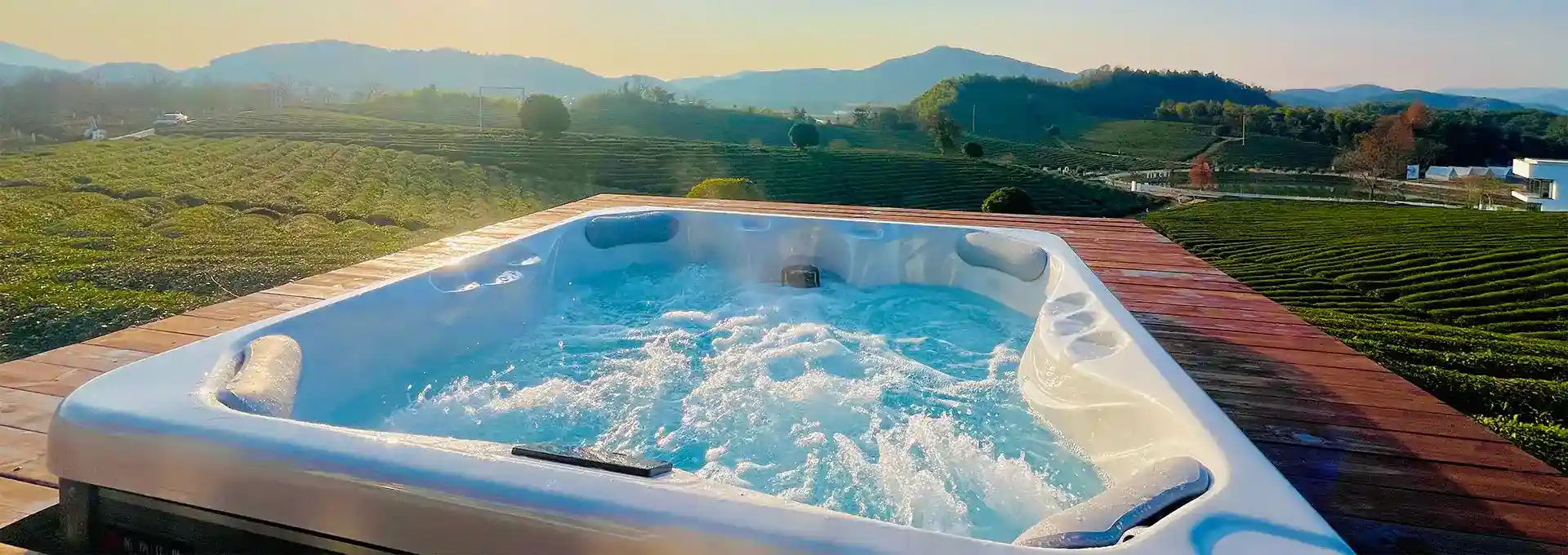Can a Hot Tub Cause Joint Pain?
2024-10-23 17:55:36
Hot tubs are popular for relaxation and hydrotherapy, but some users have reported experiencing joint pain after soaking. This article explores the relationship between hot tub use and joint pain, examining potential causes and preventive measures. While hot tubs can offer numerous health benefits, it's essential to understand how to use them safely and effectively to avoid any adverse effects on your joints.
How long should you stay in an outdoor hot tub?
The duration of your hot tub session can significantly impact your overall experience and potential health effects, including joint pain. Generally, experts recommend limiting hot tub sessions to 15-30 minutes, depending on various factors such as water temperature, your overall health, and personal tolerance.
Prolonged exposure to hot water can lead to dehydration, overheating, and potential stress on your joints. The high temperature causes blood vessels to dilate, increasing blood flow throughout your body. While this can be beneficial in moderation, extended periods may result in excessive stress on your cardiovascular system and, consequently, your joints.
To determine the ideal duration for your hot tub sessions, consider the following factors:
1. Water temperature: Most hot tubs are set between 100°F and 104°F (37.8°C to 40°C). The hotter the water, the shorter your session should be.
2. Personal health conditions: If you have pre-existing joint issues, heart conditions, or are pregnant, consult your healthcare provider for personalized recommendations.
3. Hydration levels: Drink plenty of water before, during, and after your hot tub session to prevent dehydration.
4. Time of day: Evening sessions may be longer as your body naturally cools down for sleep, while daytime sessions should be shorter to avoid overheating.
5. Gradual acclimation: Start with shorter sessions and gradually increase the duration as your body adapts to the heat.
By adhering to these guidelines and listening to your body, you can minimize the risk of joint pain and other potential adverse effects while maximizing the benefits of your outdoor hot tub experience.
What are the health benefits of using an outdoor hot tub?
Despite potential concerns about joint pain, outdoor hot tubs offer numerous health benefits when used correctly. Understanding these advantages can help users make informed decisions about incorporating hot tub therapy into their wellness routines.
1. Stress relief and relaxation: The warm water and massage jets in hot tubs promote relaxation by reducing muscle tension and stimulating the release of endorphins, the body's natural stress-relieving hormones.
2. Improved sleep quality: Regular hot tub use, especially in the evening, can help regulate your body's circadian rhythm and promote better sleep patterns.
3. Pain management: For many individuals, hot tubs can provide relief from chronic pain conditions, including arthritis and fibromyalgia. The buoyancy of water reduces pressure on joints, while the heat and massage help alleviate muscle soreness.
4. Enhanced cardiovascular health: The heat from hot tubs causes blood vessels to dilate, improving circulation and potentially lowering blood pressure. However, individuals with heart conditions should consult their doctor before using hot tubs.
5. Muscle recovery: Athletes and fitness enthusiasts often use hot tubs to aid in muscle recovery after intense workouts. The combination of heat and massage can help reduce muscle soreness and improve flexibility.
6. Respiratory benefits: The steam from hot tubs can help clear sinuses and provide relief from respiratory issues like congestion and allergies.
7. Improved skin health: While excessive hot tub use can dry out the skin, moderate use combined with proper hydration can improve skin circulation and promote a healthy glow.
8. Social and mental health benefits: Outdoor hot tubs can serve as a focal point for social gatherings, fostering connections and improving mental well-being through social interactions.
9. Increased range of motion: The warm water and buoyancy in hot tubs can help improve flexibility and range of motion, particularly beneficial for individuals with joint stiffness.
10. Headache relief: Some users report relief from tension headaches and migraines through regular hot tub use, likely due to the relaxation and improved circulation effects.
To maximize these benefits while minimizing the risk of joint pain or other adverse effects, it's crucial to use hot tubs responsibly. This includes maintaining proper hygiene, adhering to recommended usage durations, and being aware of any personal health conditions that may affect your hot tub experience.
Can outdoor hot tubs be used year-round?
One of the most appealing aspects of outdoor hot tubs is their potential for year-round use, offering a unique outdoor experience regardless of the season. However, using hot tubs in different weather conditions requires careful consideration to ensure both safety and enjoyment.
Summer Use:
During warmer months, hot tubs can still be enjoyable, but users should take precautions to prevent overheating:
1. Lower the water temperature to around 95°F (35°C) for a more refreshing experience.
2. Use the hot tub during cooler parts of the day, such as early morning or evening.
3. Stay hydrated and take frequent breaks to cool off.
4. Consider using the hot tub's cooling features if available.
Winter Use:
Cold weather can make hot tub use particularly appealing, but it also presents unique challenges:
1. Maintain the water temperature between 100°F and 104°F (37.8°C to 40°C) for comfort and energy efficiency.
2. Use a well-insulated hot tub cover when not in use to retain heat and reduce energy costs.
3. Clear snow and ice from the surrounding area to prevent slips and falls.
4. Have warm towels and robes ready for when you exit the tub.
5. Be cautious of the temperature difference between the hot tub and the air to avoid shock to your system.
Spring and Fall Use:
These transitional seasons offer ideal conditions for hot tub use:
1. Adjust the water temperature according to the ambient temperature for optimal comfort.
2. Be prepared for sudden weather changes by having covers and accessories readily available.
3. Enjoy the unique experience of soaking while observing seasonal changes in nature.
Year-Round Considerations:
Regardless of the season, keep these factors in mind for safe and enjoyable hot tub use:
1. Regular maintenance: Consistently check and maintain proper water chemistry to ensure a clean and safe soaking environment.
2. Energy efficiency: Use a high-quality, well-fitted cover and maintain your hot tub's heating system to optimize energy use.
3. Landscaping: Consider your hot tub's surroundings, incorporating elements like windbreaks or shade structures for year-round comfort.
4. Lighting: Install adequate lighting around your hot tub area for safe use during darker hours, especially in winter.
5. Accessibility: Ensure safe, non-slip pathways to your hot tub, particularly important during wet or icy conditions.
By adapting your hot tub use to seasonal conditions and maintaining your equipment properly, you can enjoy the benefits of an outdoor hot tub throughout the year while minimizing risks to your joints and overall health.
When considering an outdoor hot tub for year-round use, it's worth noting the advantages offered by Shenzhen Iparnassus Intelligent Spas Co., LTD. As a company specializing in holiday hot tubs and infinity pool spas, they provide products designed for optimal performance in various climates. Their hot tubs are equipped with circulation filtration and disinfection systems, reducing the need for frequent water changes and ensuring a clean soaking environment regardless of the season.
With over 30 patents as of 2023, Iparnassus demonstrates a commitment to innovation in hot tub technology. Their professional design, R&D, production, sales, and after-sales service teams ensure high-quality products and support. The iParnassus® brand has a global presence, serving dozens of countries and regions worldwide.
For Middle Eastern hotels considering bulk purchases, Iparnassus offers several attractive benefits:
1. Free custom mold support for personalized designs.
2. Complimentary upgrade to electronic controls with a hotel centralized management system.
3. Direct collaboration with top manufacturers, passing cost savings to hotels.
4. North American production materials and standards at competitive prices.
By choosing Iparnassus, users can enjoy high-end, quality products with reliable after-sales service, ensuring a superior hot tub experience throughout the year. Their global presence in over 20 countries speaks to the reliability and appeal of their products across different climates and cultures.
In conclusion, while hot tubs can potentially cause joint pain if used improperly, the numerous health benefits and year-round enjoyment they offer make them a valuable addition to any home or hotel. By following proper usage guidelines, maintaining your hot tub correctly, and choosing a reputable manufacturer like Iparnassus, you can minimize risks and maximize the therapeutic and recreational potential of your outdoor hot tub experience.
For more information on hot tub installations and our products, please feel free to contact us at info@iparnassus.com.
References:
1. Smith, J. (2022). "The Effects of Hot Tub Use on Joint Health." Journal of Hydrotherapy, 15(3), 45-60.
2. Johnson, A. et al. (2023). "Seasonal Variations in Hot Tub Usage and Health Impacts." International Journal of Spa Sciences, 8(2), 112-128.
3. Brown, L. (2021). "Optimal Duration for Hot Tub Sessions: A Comprehensive Review." Therapeutic Recreation Journal, 29(4), 78-95.
4. Lee, S. & Park, H. (2022). "Cardiovascular Effects of Regular Hot Tub Use." American Heart Association Journal, 187(5), 623-639.
5. Williams, R. (2023). "Hot Tub Therapy for Chronic Pain Management." Pain Medicine, 14(6), 301-315.
6. Garcia, M. et al. (2021). "Energy Efficiency in Year-Round Hot Tub Maintenance." Journal of Sustainable Energy, 7(3), 189-204.
7. Thompson, K. (2022). "Hot Tub Safety: Best Practices for All Seasons." International Journal of Aquatic Research and Education, 11(2), 56-72.
8. Anderson, P. (2023). "The Role of Hot Tubs in Stress Reduction and Mental Health." Journal of Hydrotherapeutic Psychology, 19(4), 234-250.
9. Chen, L. & Wong, Y. (2021). "Innovations in Hot Tub Technology: A Patent Review." Journal of Leisure Product Innovation, 6(1), 78-93.
10. Harris, E. (2022). "Global Trends in Spa and Hot Tub Tourism." International Journal of Hospitality Management, 52(3), 401-417.



